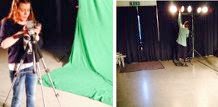For our evaluation of our finished products, my group members split the roles of answering questions.
Question 1: In what ways does your media product use, develop or challenge forms and conventions of real media products?
I answered this question, by uploading screenshots of our music video, and uploading them via www.dipity.com. With each screesnshot I added a brief description, and explained how it conformed to typical pop conventions. As well as still images of our video, I also included links of videos of other pop artists. I did this to make links of similarities between our music video, and other pop videos. Overall i found that our pop video, mainly successfuly conformed to typical conventions of the pop genre. I have also included the link:
http://www.dipity.com/Ishpreet/In-what-ways-does-or-media-product-use-develop-or-challenge-forms-and-conventions-of-real-media-products/
Rumena Ahmed answered this question, by using a prezi presentation:
Question 1: In what ways does your media product use, develop or challenge forms and conventions of real media products?
I answered this question, by uploading screenshots of our music video, and uploading them via www.dipity.com. With each screesnshot I added a brief description, and explained how it conformed to typical pop conventions. As well as still images of our video, I also included links of videos of other pop artists. I did this to make links of similarities between our music video, and other pop videos. Overall i found that our pop video, mainly successfuly conformed to typical conventions of the pop genre. I have also included the link:
http://www.dipity.com/Ishpreet/In-what-ways-does-or-media-product-use-develop-or-challenge-forms-and-conventions-of-real-media-products/
In what ways does your media product use, develop or challenge forms and conventions of real media products? on Dipity.
Although our music video has conformed to conventions of pop; there are areas which we could improve to appear more conventional. For example it would have been more typical for our dancers, to perform a set routine. They instead took to mainly carrying out different moves from one another. We subverted the typical convention of the lead having a prominent love interest throughout the video. Instead we subtly indicate that Kala (lead) was involved with a love interest; as in the bedroom scene she wakes up in a oversized shirt which could belong to a male, whith whom she.
Question 2: How effective is the combination of your main product and ancillary texts?
Rumena Ahmed answered this question, by using a prezi presentation:
Question 3: What have you learned from your audience feedback?
For this part of the evaluation, Chloe Connell and I decided to create a news report. Before answering our question, Chloe typed our answer into www.cueprompter.com, so that i could read out the question with ease. Below is a screenshot of the cue prompter, taken by Chloe:
We then edited the question, and Chloe Connell then uploaded it via YouTube:
For this part of the evaluation, Chloe Connell and I decided to create a news report. Before answering our question, Chloe typed our answer into www.cueprompter.com, so that i could read out the question with ease. Below is a screenshot of the cue prompter, taken by Chloe:
We then edited the question, and Chloe Connell then uploaded it via YouTube:
Question 4: How did you use media technologies in the construction of the research, planning and evaluation stages?
Chloe answered this question, by using www.timetoast.com. She acknowledged the different types of media technologies, that we used within our research, planning and evaluation.










